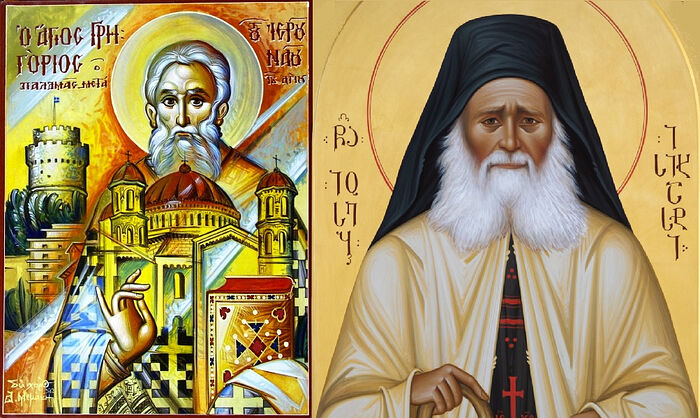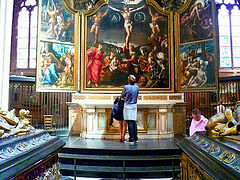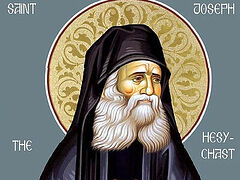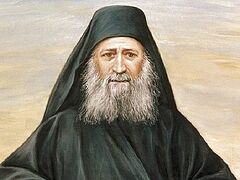This second Sunday of Great Lent is dedicated to the fourteenth-century Holy Hierarch St. Gregory Palamas. It is considered a continuation of last week’s celebration of the Triumph of Orthodoxy because it represents another overthrow of soul-destroying heresy, another defense of soul-saving truth.
St. Gregory is the Father most associated with the teaching of the essence-energies distinction in God and the practice of hesychasm that flows from it. Of course, St. Gregory didn’t invent this teaching, rather he more fully articulated the experience of all the saints throughout the ages, and ably defended it against the heretics of his day who rejected the teaching that man can have direct experience of God through His energies.
The Scriptural event most associated with the essence-energies distinction and hesychasm is surely the Transfiguration, when the incarnate Christ revealed the uncreated glory of God that had always been His. While the Transfiguration is a revelation of the divinity of Christ, it is not only a revelation of the divinity of Christ, but rather it also shows us to what heights mankind is called.
It’s not for nothing that Christ was transfigured in the flesh.
All men are called to become by grace what Christ is by nature. Though we are created, we are called to be filled to overflowing with Divine grace, to live the life of the Holy Trinity.
In a passage from his first homily on the Transfiguration, St. Gregory briefly describes the theological controversy of his day:
There are people in our times, who boast of pagan Greek learning and the wisdom of this world, and who completely disobey spiritual men in matters of the Spirit, and choose to oppose them. When they hear that the light of the Lord’s Transfiguration on the mountain was seen by the eyes of the Apostles, they immediately reduce it to visible, created light. They drag down that immaterial, never-setting, pre-eternal light, which surpasses not only our senses but also our minds.
And he goes on to succinctly explain how people can so radically fail to understand this light:
They themselves are at a low level, and are incapable of conceiving of anything higher than earthly things.[1]
This is the essence of any heresy or distortion of spiritual practice: People who lean on the wisdom of this world rather than the wisdom of the Spirit, who are lacking in the spiritual life, can’t comprehend the heights of the spiritual life of the saints, and much less God.
Such people always exist in the Church, and certainly the lure of the wisdom of the world is as strong as ever today, if not stronger.
But at the same time, there are always those who seek for what is above, who seek to acquire the mind of Christ and to know the sweetness of Divine grace. Among the most laudable examples of such men of recent times is surely St. Joseph the Hesychast († 1959).
From a young age, St. Joseph knew that there was nothing better with which he could occupy his mind than the pursuit of God. Having had an experience of our Lord Jesus Christ in a dream, and marveling at the lives of the saints he began to read soon after, St. Joseph’s heart was set aflame with a desire to know Christ, and nothing else.
As a young man still in the world, before he departed for Mt. Athos, he gave up his work as a merchant and began to take on just enough menial work to survive. “These simple jobs gave him the freedom to occupy himself with prayer while he worked,” his disciple Elder Ephraim later recounted.[2]
Likewise, on the Holy Mountain, he survived by making only the simplest of handicrafts so as not to distract his mind from its true work. According to St. Sophrony (Sakharov) the Athonite, one hour of true, concentrated prayer is equal to seven or eight hours of manual labor. Thus, while outwardly he may have appeared relatively inactive, he was, in fact, a man of the most intense labor.
And while heretics are men “who completely disobey spiritual men in matters of the Spirit,” St. Joseph and his companion-disciple Fr. Arsenios, conversely, spent months and even years seeking out spiritual men in the hidden sketes of caves of Mt. Athos. They were never content with the current state of their spiritual lives, but always sought to master yet another virtue, to achieve a yet higher state of prayer.
Ultimately, they wanted nothing more than to have direct, experiential knowledge of the Lord Jesus Christ, which is precisely the experience that St. Gregory Palamas defended with his teaching. St. Gregory and St. Symeon the New Theologian before him teach us that the desire for and attainment of the vision of God is the sign of a healthy Christian soul.
While those living in the world can’t exactly imitate the outward conditions of the life of a great saint such as St. Joseph the Hesychast, we can imitate his spirit and his desire.
We sometimes hear that seeking out experienced spiritual guides is only for the monastics, but the Church knows no separate theologies for monastics and the laity; the monastics don’t possess their own peculiar nature with its peculiar requirements for salvation. All Orthodox Christians are called to the same purification, glorification, and illumination; and if the monastics need experienced spiritual guidance, so do the laity. Someone who has defeated the passion of anger, for example, is able to teach another how to overcome it.
And St. Joseph was merciless with himself to overcome the passions that prevented him from experiencing God more fully; he was merciless with himself in his pursuit of ceaseless noetic prayer: The Kingdom of Heaven suffereth violence, and the violent take it by force (Mt. 11:12).
St. Joseph would physically beat himself to stop the movements of the passions, he would fast for days on end, for years he never laid down to sleep. He shows us that the spiritual battle is a real, unceasing battle. While our labors can never save us, they do show God that we are serious about our pursuit of Him, and in turn He grants us His grace. Salvation means to be detached from all things created, including our own flesh, and attached only to the Uncreated God.
While, again, we can’t simply imitate the exact circumstances of the life of St. Joseph and other such saints, there is always something more that we can be doing, another sacrifice we can offer out of love for God.
St. Joseph says:
The struggle against self-love is hard, but everything is accomplished with the grace of God. If a person—especially a beginner—is not strict with himself, cowardice and self-love take the wind out of his sails. And if a person does not jump into the sea of temptations with faith and without hesitating, he will not find tangible help from God and thus will not make even one step of progress.[3]
There is much more that could be said about the great St. Joseph the Hesychast, but it’s clear that all his labors—the humbling of his mind and its dedication to prayer, his heartfelt search for spiritual guidance, his uncompromising approach to himself and his own spiritual life—brought him much tangible help from God and exalted him to the heights.
St. Ephraim of Katounakia, a disciple of St. Joseph, says of him: “Elder Joseph was a spiritual giant and a teacher of noetic prayer taught by God… I believe that Elder Joseph reached higher levels than St. Silouan the Athonite—much higher, in fact. Nowadays there are no figures like him anymore.”[4]
And if the Sunday of St. Gregory Palamas is a continuation of that of the Triumph of Orthodoxy, St. Joseph can be seen as a continuation of St. Gregory. Elder Joseph of Vatopedi, another of St. Joseph’s disciples, reflects:
The spiritual renewal on the Holy Mountain … is largely due to Geronda. Back then Mount Athos was decaying, and the inner spiritual work of monasticism, which constitutes genuine theology, was neglected. If this spiritual work is flourishing on the Holy Mountain, it is primarily due to Elder Joseph the Hesychast and Cave-dweller, whose immense impetus brought back to the Athonite environment the true meaning and continuation of the theology of St. Gregory Palamas.[5]
On this second Sunday of Great Lent, the holy Church reminds us of the glory of Christ that is to be ours as well. St. Gregory lived in the fourteenth century, but he faithfully transmitted the same theology that the Church has lived in every age; he lived in the fourteenth century, but his teaching remains relevant for us today. Truth is unchanging.
His experience remains possible for us today, something to which St. Joseph the Hesychast wondrously testifies, inspiring us with his zeal and guiding us with his ascetic endeavors.





